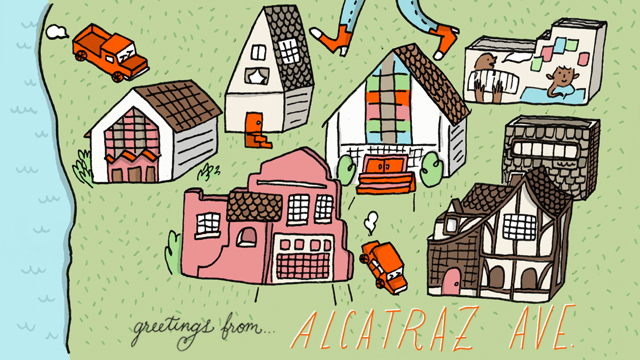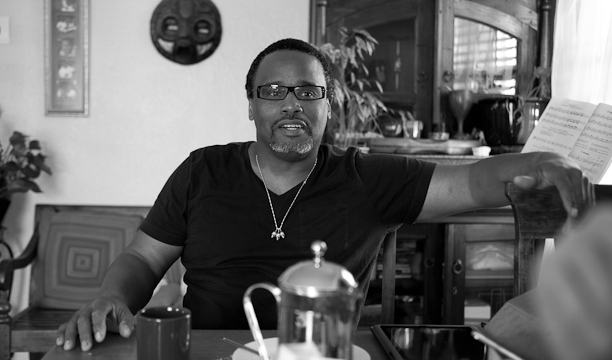How he ended up in the neighborhood:
My mom had an entrepreneurial streak. Even though she retired as a social worker, one of the things she always wanted to do was buy property. One of the houses we first bought as a family was this particular house. Before then, we grew up in Berkeley, since I was five years old, so I’ve been here for a while.
About the neighborhood:
Berkeley itself is a city of duality. It’s always been, even from its conception. It was formed based on two different cities. There’s always been a sense of Berkeley as a really liberal city, but at the same time it’s also a very conservative city. There’s that duality.
The demographics are changing. The people that are buying in the neighborhood are not entry level and mid-level working class people. This house is probably worth $600k. I would be pressed to pay $600k for a house this size. The older group of working class people are no longer able to afford the properties that are here. With the jobs that are being presented [around the Bay Area], incomes are really high. So affordability may not be that big of a deal for an increasing group of people in this particular area.
The neighborhood is changing. Whether or not it’s a good thing or a bad thing, it’s both. I’m glad to see a neighborhood that’s more vibrant. I’m glad to see a neighborhood that’s a little more sustainable. I’m sad to see the history of the neighborhood change.
About the nature of change:
In this day and age, you really have to be aware of change, how to change and be flexible, how to redefine yourself every three to four years. That’s one of the reasons I got out of tech. Because I was like, “Oh man, this is crazy. I mean, I’m learning new languages every six months. This is crazy, crazy, crazy.” So basically that whole concept is applying to everybody. Sometimes, if you don’t change, your ability to generate revenue to maintain your standard of life becomes very difficult.
No neighborhood stays the same; everything is constantly in a state of change. It’s kind of hard to define a good change or a bad change. It just really depends on what part of the change you’re on. Sometimes you wish for change and it never happens! But such is life. You know, you keep living.
About education:
Jerry Brown did a really, really good job of revitalizing downtown Oakland, but what he didn’t do was worry about the jobs that could support that. He focused on blight and activity and violence. The next group really are focused a little bit more on jobs, which is important, but it’s a double-edged sword. If you are bringing in new people to satisfy the needs of the employers, then you’re gonna have a gentrification issue, whereas if you prepare the existing population for those opportunities, then it’s more of a balance in terms of maintaining the neighborhood.
Satisfying that part is not a quick fix. It’s not one of those flashy media lines that you hear about. It’s a very difficult job. The school systems in Oakland are very poor. To a certain degree it becomes a societal issue or a municipal issue to bring the pool of people up to par in terms of education so they’re ready for the new opportunities that are inevitable to come. There are always opportunities, but you’ve gotta be ready to act on them.
How can we maintain the good while we keep changing?
I think one of the biggest problems with change: people don’t really respect history. You’ve gotta value history to really be effective in the future. You’ve gotta take a look at what happened, and you’ve gotta make a cognitive decision that you’re going to do whatever it is that you can to make it better. If you understand that people have a history and that history is important to them, then you can be a little more compassionate about their story, where they came from, where they’re going.
“Such-and-such-down-the-street’s grandson can’t get a job. But I do know that there’s a tech company that has an internship and has a training program or something. Let’s connect these people. Let’s see what can happen.” Just in making that effort -- to link the old and new -- it makes it better. And it shows a human compassion for another person’s state of being. To me, that’s about all you can do. And everybody can do that. Anybody.
About coffee:
Recently I got exposed to roasting coffee. My first exposure: I’m on the internet looking around and it’s like, you can make coffee with a popcorn popper. And I’m like, “Oh…an air popper. I got one of those.” So I looked around and I found out there’s a place called Sweet Marie’s, which is where most of the home roasters buy coffee. They’re right in West Oakland. I spent 20 bucks and they gave me like [several] pounds of different kinds of coffee. And I popped it. In the popcorn popper. And it was really good!
I’ve been progressing ever since. It’s very much an artistic endeavor in that you’re trying to bring something out of a raw material and have it express something that you are trying to say. You’re trying to bring out all of what you see as its best characteristics or manipulate it in such a way that you can make it express a certain thing on your palate.
It’s rewarding that people like it, number one. And exposing [my kids] to a process of taking a raw material, adding value to it, and then seeing people appreciate that value. being able to reap a small reward for it, that’s a lesson that I think is really valuable.



